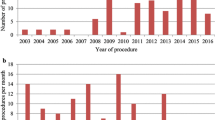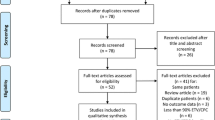Abstract
Purpose
Surgery for children in developing nations is challenging. Endoscopic third ventriculostomy (ETV) is an important surgical treatment for childhood hydrocephalus and has been performed in developing nations, but with lower success rates than in developed nations. It is not known if the lower success rate is due to inherent differences in prognostic factors.
Methods
We analyzed a large cohort of children (≤20 years old) treated with ETV in developed nations (618 patients from Canada, Israel, United Kingdom) and developing nations of sub-Saharan Africa (979 patients treated in Uganda). Risk-adjusted survival analysis was performed.
Results
The risk of an intra-operative ETV failure (an aborted procedure) was significantly higher in Uganda regardless of risk adjustment (hazard ratio (HR), 95% confidence interval (CI), 11.00 (6.01 to 19.84) P < 0.001). After adjustment for patient prognostic factors and technical variation in the procedure (the use of choroid plexus cauterization), there was no difference in the risk of failure for completed ETVs (HR, 95% CI, 1.04 (0.83 to 1.29), P = 0.74).
Conclusions
Three factors account for all significant differences in ETV failure between Uganda and developed nations: patient prognostic factors, technical variation in the procedure, and intra-operatively aborted cases. Once adjusted for these, the response to completed ETVs of children in Uganda is no different than that of children in developed nations.


Similar content being viewed by others
References
Copeland GP (2002) The POSSUM system of surgical audit. Arch Surg 137:15–19
Dawwas MF, Gimson AE, Lewsey JD, Copley LP, van der Meulen JH (2007) Survival after liver transplantation in the United Kingdom and Ireland compared with the United States. Gut 56:1606–1613
Drake JM (2007) Endoscopic third ventriculostomy in pediatric patients: the Canadian experience. Neurosurgery 60:881–886
Javadpour M, Mallucci C, Brodbelt A, Golash A, May P (2001) The impact of endoscopic third ventriculostomy on the management of newly diagnosed hydrocephalus in infants. Pediatr Neurosurg 35:131–135
Javadpour M, May P, Mallucci C (2003) Sudden death secondary to delayed closure of endoscopic third ventriculostomy. Br J Neurosurg 17:266–269
Javadpour M, Mallucci C (2004) The role of neuroendoscopy in the management of tectal gliomas. Childs Nerv Syst 20:852–857
Kleinbaum DG, Kupper LL, Muller KE (1988) Collinearity concepts. Applied regression analysis and other multivariable methods. Wadsworth, Belmont, pp 209–214
Kombogiorgas D, Sgouros S (2006) Assessment of the influence of operative factors in the success of endoscopic third ventriculostomy in children. Childs Nerv Syst 22:1256–1262
Kulkarni AV, Drake JM, Mallucci CL, Sgouros S, Roth J, Constantini S (2009) Endoscopic third ventriculostomy in the treatment of childhood hydrocephalus. J Pediatr 155:254–259
Larrazabal LA, Jenkins KJ, Gauvreau K, Vida VL, Benavidez OJ, Gaitan GA, Garcia F, Castaneda AR (2007) Improvement in congenital heart surgery in a developing country: the Guatemalan experience. Circulation 116:1882–1887
O’Brien DF, Javadpour M, Collins DR, Spennato P, Mallucci CL (2005) Endoscopic third ventriculostomy: an outcome analysis of primary cases and procedures performed after ventriculoperitoneal shunt malfunction. J Neurosurg 103:393–400
O’Brien DF, Hayhurst C, Pizer B, Mallucci CL (2006) Outcomes in patients undergoing single-trajectory endoscopic third ventriculostomy and endoscopic biopsy for midline tumors presenting with obstructive hydrocephalus. J Neurosurg 105:219–226
O’Brien DF, Seghedoni A, Collins DR, Hayhurst C, Mallucci CL (2006) Is there an indication for ETV in young infants in aetiologies other than isolated aqueduct stenosis? Childs Nerv Syst 22:1565–1572
St George E, Natarajan K, Sgouros S (2004) Changes in ventricular volume in hydrocephalic children following successful endoscopic third ventriculostomy. Childs Nerv Syst 20:834–838
Warf BC (2005) Comparison of 1-year outcomes for the Chhabra and Codman-Hakim Micro Precision shunt systems in Uganda: a prospective study in 195 children. J Neurosurg 102:358–362
Warf BC (2005) Comparison of endoscopic third ventriculostomy alone and combined with choroid plexus cauterization in infants younger than 1 year of age: a prospective study in 550 African children. J Neurosurg 103:475–481
Warf BC (2005) Hydrocephalus in Uganda: the predominance of infectious origin and primary management with endoscopic third ventriculostomy. J Neurosurg 102:1–15
Warf BC, Campbell JW (2008) Combined endoscopic third ventriculostomy and choroid plexus cauterization as primary treatment of hydrocephalus for infants with myelomeningocele: long-term results of a prospective intent-to-treat study in 115 East African infants. J Neurosurg Pediatr 2:310–316
Warf BC, Mugamba J, Kulkarni AV (2009) Endoscopic third ventriculostomy in the treatment of childhood hydrocephalus in Uganda: report of a scoring system that predicts success. J Neurosurg Pediatr. 2010 Feb; 5(2):143–8.
Yii MK, Ng KJ (2002) Risk-adjusted surgical audit with the POSSUM scoring system in a developing country. Physiological and Operative Severity Score for the enUmeration of Mortality and morbidity. Br J Surg 89:110–113
Funding
No external funds were received for this study. The authors have no conflicts of interest related to this manuscript. Dr. Kulkarni had full access to all of the data in the study and takes responsibility for the integrity of the data and the accuracy of the data analysis.
Author information
Authors and Affiliations
Consortia
Corresponding author
Additional information
Canadian Pediatric Neurosurgery Study Group (see Appendix 1 for list of members)
Appendix 1. Contributing members of the Canadian Pediatric Neurosurgery Study Group
Appendix 1. Contributing members of the Canadian Pediatric Neurosurgery Study Group
Alberta Children’s Hospital, Calgary, Canada: W Hader; M Hamilton; Children’s & Women’s Health Centre of BC, Vancouver, Canada: DD Cochrane, P Steinbok; Children’s Hospital of Eastern Ontario, Ottawa, Canada: M Vassilyadi, E Ventureyra; Hospital for Sick Children, Toronto, Canada: PB Dirks, JM Drake, AV Kulkarni, JT Rutka, A Van der Stoel, I Veltman; IWK Health Centre, Halifax, Canada: W Howes, PD McNeely, SA Walling; London Health Sciences Centre, London, Canada: A Ranger; Montreal Children’s Hospital, Montreal, Canada: J Atkinson, JP Farmer, J Montes; Stollery Children’s Hospital, Edmonton, Canada: K Aronyk, V Mehta; Winnipeg Children’s Hospital , Winnipeg, Canada: PJ McDonald
Rights and permissions
About this article
Cite this article
Kulkarni, A.V., Warf, B.C., Drake, J.M. et al. Surgery for hydrocephalus in sub-Saharan Africa versus developed nations: a risk-adjusted comparison of outcome. Childs Nerv Syst 26, 1711–1717 (2010). https://doi.org/10.1007/s00381-010-1195-x
Received:
Accepted:
Published:
Issue Date:
DOI: https://doi.org/10.1007/s00381-010-1195-x




